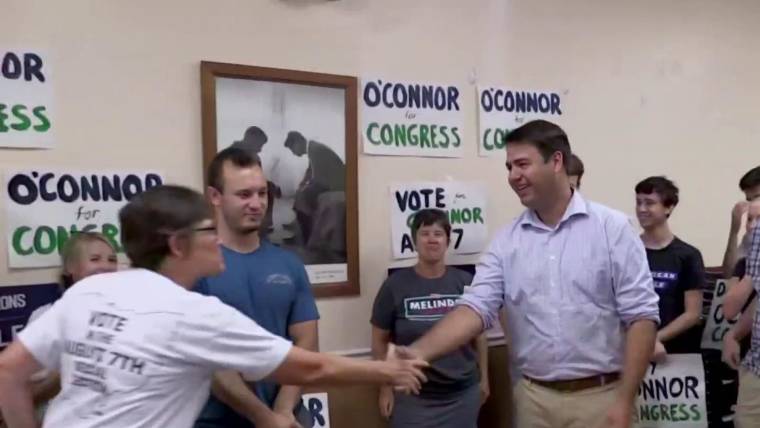Breaking News Emails
WASHINGTON — The congressional special election in Ohio is going down to the wire.
With 99 percent of precincts reporting, the race is neck-and-neck, with Republican Troy Balderson moving into a narrow lead over Democrat Danny O'Connor. Balderson, buoyed by the district's more rural areas, leads 50.1 percent to 49.3 percent, or 100,052 votes to 98,364 votes.
The race could be headed to a recount as state law mandates one if the candidates are within half a percent of each other.
Meanwhile, in a Michigan Democratic gubernatorial primary, Gretchen Whitmer easily defeated Abdul El-Sayed, a Bernie Sanders-backed candidate who was seeking to become the first Muslim governor in the country, the AP projected.
And in Missouri, voters appear on track to vote down a Right to Work law that the Republican-controlled state legislature passed last year, but which unions challenged by putting it on Tuesday's ballot as a referendum.
President Donald Trump endorsed Balderson and swung through the 12th Congressional District on Saturday to campaign for the GOP hopeful. And outside Republican groups have spent millions to try to defeat O'Connor.
Trump won the Central Ohio district by 11 percentage points in 2016, but a backlash to his presidency has fueled Democratic enthusiasm.
Both parties see the election as a test of Trump's strength and as a potential bellwether before the November midterms, when Democrats are hoping to pick up the 23 seats they need to flip the House.
"It's very close," Balderson, a state legislator, told reporters Monday. "It has brought so much enthusiasm out to have both the vice president of the United States and the president of the United States here within six days of each other. It's just huge."
Ohio Democratic candidate gains support in Republican district
Aug.07.201803:59In his corner, Balderson also has Ohio Gov. John Kasich, who hasn't seen eye to eye with Trump on almost anything else.
"It's really kind of shocking because this should be just a slam dunk (for Republicans) and it's not,” Kasich said Sunday on ABC’s This Week.
"The chaos that seems to surround Donald Trump has unnerved a lot of people," Kasich added. "Suburban women in particular here are the ones that are really turned off."
The district includes two kinds of voters the parties have been fighting over in the Trump era: Historically Republican suburbanites, who have been trending Democratic, and traditionally Democratic blue-collar whites who have been wooed by Trump to the GOP side.
O’Connor, 31, a county official who has made a point of saying he would not vote for House Minority Leader Nancy Pelosi as speaker if the Democrats take control, has tried to contrast his low-key demeanor and focus on pocketbook issues.
"I hope people go out and talk about bread and butter issues that matter to working families because working families don't have anyone's who's fighting for them right now in know in Washington, D.C.," O’Connor told MSNBC’s Garrett Haake when asked what Democrats could learn from his campaign.
Starting last year, Republican groups have spent more than $40 million on TV ads to defend just a handful of congressional seats in their own turf in special elections.
Republicans have won five out of seven competitive House and Senate special elections this cycle, but it's come at a price.
Democrats outperformed historical benchmarks in every case, even though they only managed to notch wins in the Alabama Senate race and a Pennsylvania special election.
Still, the string of races confirmed the enthusiasm gap opposition parties often enjoy in the first midterm of a president's tenure. And they forced Washington Republicans to prop up candidates who had difficulty raising money or building momentum on their own.
In Ohio, the biggest spender has been the Congressional Leadership Fund, a major conservative super PAC aligned with Speaker Paul Ryan, which has run $2.7 million in TV ads, according to Advertising Analytics. By contrast, Balderson's campaign itself has spent only $515,000 on TV.
O’Connor’s campaign, meanwhile, has spent $2.3 million on ads, which have likely had a bigger impact than the super PACs, thanks to discounted rates available only to candidates.
All told, five of the biggest GOP outside groups — the Republican National Committee, the party’s official House and Senate campaign arms, plus the Congressional and Senate Leadership Fund super PACs — spent $36.95 million on TV ads in the seven special elections before Ohio, according to Advertising Analytics. And they've dropped close to $5 million more in Tuesday’s race.
That's compared to just $11.5 million from their five Democratic counterparts, who have had to spend less since their candidates have been able to raise more money on their own and needed less help.

